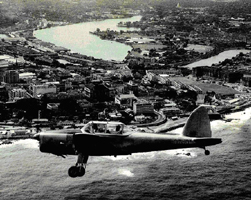SLAF History : Early Wings

 At inception, the RCyAF owned no aircraft. Early recruits had to make do with PT and Drill routines,until the first four Chipmunks arrived, and later the Oxfords and Balliols as well. The RCyAF's first trainer, the Chipmunk was ordered in 1950 and the first batch of four aircraft arrived in Ceylon in October the same year. With the arrival of the Chipmunk, aircraft engineering activities could begin.The aircraft were brought in and assembled at Katunayake, under the guidance of RAF Engineers and were first flown in February 1951.
At inception, the RCyAF owned no aircraft. Early recruits had to make do with PT and Drill routines,until the first four Chipmunks arrived, and later the Oxfords and Balliols as well. The RCyAF's first trainer, the Chipmunk was ordered in 1950 and the first batch of four aircraft arrived in Ceylon in October the same year. With the arrival of the Chipmunk, aircraft engineering activities could begin.The aircraft were brought in and assembled at Katunayake, under the guidance of RAF Engineers and were first flown in February 1951.The receipt of aircraft heralded the conferring of Station status on RCyAF, Katunayake. A second batch of five Chipmunks joined the fleet in July 1952 and began flying in November 1952.
The last batch of Chipmunks was purchased in March 1953 and commissioned in August the same year. Also in 1953, the Air Force took delivery of three Airspeed Oxford aircraft. The arrival of the twin engined Airspeed Oxford aircraft enabled the Flying wing to become operational, engaging in anti-illicit immigrant sorties.
Incidentally, the Rolls Royce Merlin engine on the Balliol came from the same stable as the power units of the renowned Spitfire aircraft of World War II fame. The Balliols were significantly more powerful than the sedate Oxfords and Chipmunks, and many an RCyAF Cadet pilot found them brutes to fly yet a few of those Cadets like Paddy Mendis, Harry Goonetileke and Dick Perera have admitted that of all the aircraft they had flown, the most challenging and rewarding to fly, were the Balliols. It was a matter of feel and control etc
Three years after birth, the RCyAF took delivery of its first batch of Merlin-engined Boulton Paul Balliol aircraft, heralding the commencement of advanced flying training activities, long delayed up to that juncture. The prowess of our pilots was really second to none. The confident young RCyAF pilots did Ceylon proud in the UK. Squadron Leader S.V. Mahendra Situnayake became the second Asian pilot to win the Groves Memorial Prize for Flying and Airmanship at Cranwell, the first being ACM Mukherjee of the Indian Air Force. Squadron Leader J.E.M. Nihal Ratnayake became the first Asian pilot to win the Hicks Memorial Prize for Aerobatics, also at Cranwell. These were not easy heights to reach and easy awards to obtain for Asians, in those days.
It wasn' t until 1955 when the De Havilland Dove aircraft joined the fleet, that the Air Force began to operate two squadrons - No. 1 Squadron, to which the Chipmunks and Balliols were attached (and consequently was the training wing) and No. 2 Squadron to which the Doves were attached. With the arrival of the Doves in 1955, the force also acquired two Westland S 51 helicopters, commonly known as the Dragonfly. Another acquisition at the time was of four Prestwick single engine Pioneer aircraft which were deployed in the role of crop sprayers and transporters.
Thus did the fledgling Air Force fleet grow in the early years.















